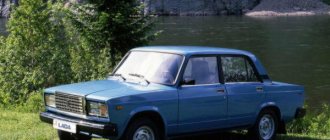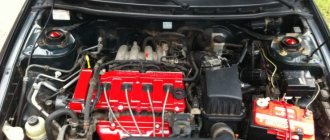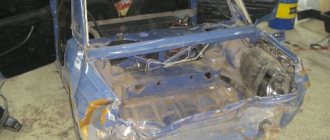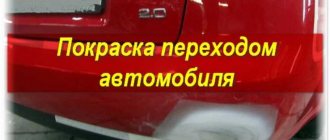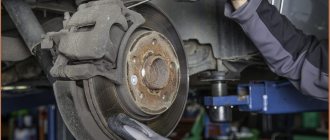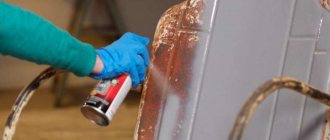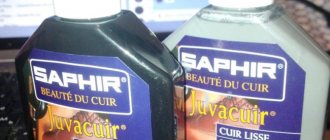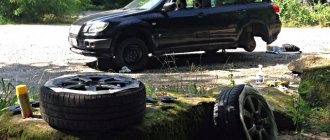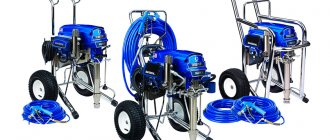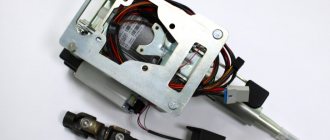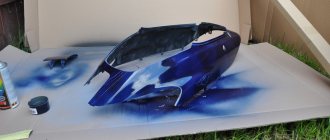Paint selection
First of all, you need to choose a paint, and here various options are possible. VAZ 2106 cars are most often painted with acrylic or metallic paint. The choice of paint can be influenced by the result of a simple test. To carry it out, wipe an inconspicuous part of the body with a small piece of cloth soaked in a solvent. The appearance of paint on this rag indicates that acrylic paint was used to paint the car. If a piece of material remains clean, then the top layer is varnish. The technology for applying acrylic paint is quite simple. Many car enthusiasts prefer this variety when painting their car.
Choice of paint coating
A VAZ car is coated with a multi-layer paint coating, the quality, manufacturer and price of which will depend on the financial capabilities and wishes of the owner. Therefore, the question of choosing a material, as well as the technology for its application, lies entirely with you.
As a rule, it includes a standard set: primer, paint and varnish
Please note that only if the technological requirements are fully and carefully followed when applying all layers, high-quality protection and a presentable appearance will be obtained. The paint used to paint cars can be aerosol or powder
The most modern and high quality, naturally - powder. Spraying at high temperatures causes the coating to polymerize, which becomes smooth and durable. This type of paint has increased resistance to aggressive external factors and provides good body protection.
Preliminary work to prepare the car for painting
Directly painting a car with your own hands takes 1/10 of the time spent on the entire operation, and the remaining 9/10 is occupied by preparatory work for painting. They represent the following sequence of actions:
- The first step is to clean the car from dirt, dust and grease stains using detergents and white spirit. Gasoline and solvents should not be used for this purpose.
- Then you need to remove from the body all parts that may interfere with painting. To do this, both bumpers, all headlights, the radiator grille, all devices for outdoor lighting, and antennas are removed.
- The next step is to clean up surface defects on the body. In good lighting, dents, chips, and scratches on the car's surface are identified and marked. Using a chisel and sandpaper, clean the marked areas to the metal surface. After completing the operation, remove dust again using a piece of cloth soaked in white spirit.
- Next, the surface is primed with a two-component acrylic primer, and all defects are puttied with polyester putty and primed again.
- We sand the primer with sandpaper and move on to painting.
Types of body work
Body work should include the following types of work:
- Restoration of the factory body configuration, involving a return to the factory parameters of the car. If the geometry of the body tail is violated, the vehicle's driving performance deteriorates, fuel consumption increases, and vehicle control becomes more difficult, which can create the preconditions for new traffic accidents;
- Lako - paint work that is carried out after body work has been performed on equipment;
- Selective painting, during which small defects of individual body elements are subject to painting with a selected color scheme;
- Polishing the body using abrasive materials is part of the restoration work. This type of work is required when the paintwork has a lot of damage in the form of shallow scratches and small defects. In this case, the damage should be shallow, at the level of ground materials, without damaging the main paint of the body elements.
- Elimination of individual areas of corrosion and rust. Such damage occurs during long-term use of equipment. To remove them, it is necessary to clean the damaged area of the body plumage down to the metal surface using rust converters;
- Removing dents using a paintless method using the “Dellen ohne Lackieren” technology. Using this technology, dents are removed without damaging the paintwork, leaving no traces of restoration activities;
- Repair work on the front and rear bumpers;
- Repair of car thresholds, which is associated with restoration work to restore places for the jack;
- The work of a master tinsmith;
- Works of a master welder;
- Work with a slipway, which is a unit used for restoring a car body after an accident, which is intended for work on restoring a car body;
- Straightening work as the main type of body repair.
All types of work are carried out at a service station; it is also possible to repair the body of a VAZ 2106 with your own hands, a video of which is posted on our website.
Painting with acrylic paint
Painting can be done by hand. When performing this, three layers of paint are applied. The first layer is the thinnest and is the basis for the next one; the third layer is slightly diluted and applied not as thoroughly as the previous ones. Varnishing will improve its quality and give greater depth of color. To successfully complete the work, you need to wait until the surface is completely dry and sand it with fine-grained sandpaper. When painting a car yourself, apply the paint using a sprayer.
The main concern when performing work is protective measures against dust ingress. For this purpose, use paper or medical tape.
DIY airbrush stencils
Stencils are classified according to several parameters. Depending on the possibility of reuse, they are:
- Disposable (most often used to complete individual orders or such work that can be completed only once). They are made of self-adhesive film (very convenient, since they can be glued to almost any prepared surface, in addition, they do not need to be secured additionally) or of cardboard.
- Reusable - in most cases they are used in cases where it is necessary to apply a multi-layer image.
They are made from:
- Plastic (plotter cutting).
- Metal-plastic.
- Polyvinyl chloride.
You can secure such a stencil using aerosol glue and additionally secure it with masking tape. Professional painters who apply airbrushing to cars recommend using such stencils only on flat surfaces of the body, since there is a high risk that the paint will get under the stencil.
Classification of stencils according to their purpose:
- Support (made from plain paper and in most cases used only once, as it is soaked with paint). Its main function is to maintain the proportions of the design when transferred to the vehicle body.
- Local (can be made of paper or self-adhesive tape). With its help, the details of the picture are drawn, you can achieve the desired color effect, or simply make several copies of the same element).
- Pattern (made of plastic). Masters use it to quickly draw silhouettes and some elements of drawings.
Where can I get a stencil? The simplest way is to make it yourself from thick paper or cardboard. The required design is drawn on it by hand, then its contours are cut out with sharp scissors.
You can download a ready-made drawing from specialized forums or websites. Such a drawing will not be original, but it will save a lot of time and effort if you simply do not have the necessary practical skills to do the work yourself. The stencil is printed and cut out.
Some tips when performing airbrushing:
- The airbrush must be held strictly perpendicular to the surface being treated.
- It is advisable to practice before work to avoid smudges and to avoid having to do the work again.
- Since dark shades are difficult to paint over, you should always start painting with light ones.
- Apply the next coat of paint only after the previous one has completely dried. If you apply the paint too thickly, smudges may form. They need to be removed only after drying using a special roller that has previously been soaked in a solvent.
- In order for light shades to fit well on top of dark ones, you need to use a white base.
Metallic paint
Metallic painting technology has its own characteristics, which consist in the fact that a layer of varnish is applied to the main paint coating. The name of the paint is due to the fact that aluminum powder is added to the varnish. Thanks to its presence, the effect of polished metal occurs. At the same time, the varnish clearly reveals all the flaws made during the preparation process, which indicates the need to carefully carry out all preparatory operations. The surface is varnished in 2-3 layers using the same paint gun. Wash it thoroughly before use.
Metallic paint
(Base+varnish)
Painting metallic is not as easy as it might seem at first glance:
- It is necessary to adhere to technology
- High demands on materials and equipment
- Very high level of preparation before painting
- Does not tolerate the slightest irregularities or rust
- Requires experience and dexterity from the painter
Metallic painting itself is the application of several layers of a base, which gives color, followed by varnishing in a certain number of layers. The whole difficulty is to first apply the base exactly, and then also the varnish. If the quality of the equipment is poor, stripes may appear on the base, non-proceras, and other things. In a word, I do not recommend it to those people who have never held a gun in their hands. Also, metallic very well reveals all the unevenness of the body, unpolished putty, etc. Painting a metallic paint on an old, beat-up car is a tedious and difficult task. I recommend it to those who know how to paint and paint a fresh car.
Airbrushing VAZ 2106
Airbrushing is one of the ways to paint a car. Airbrush is a method of applying various images to the body of a car. Made by a talented artist, they turn the car into a true work of art. The unique designs allow it to stand out from the crowd of similar VAZ 2106 cars, making it original and unique. In addition, it makes no sense to steal such a car, since it will be quickly found.
Airbrushing performed on a VAZ six is no different from standard painting work, except for one thing. The difference is that the preparation is done with greater care and diligence. Of all the methods of obtaining a pattern, preference should be given to the method of applying it using an airbrush. It is a small spray bottle for drawing thin, clear lines. The design is obtained by applying at least five layers of paint, and each layer is dried at high temperature.
Process technology
The VAZ 2106 body is straightened immediately before painting the restored part:
- The surface to be treated is cleaned of dirt, washed, dried and degreased. Remove old paint from the working surface.
- Use frequent gentle blows of a hammer to smooth out the dent. If the defect is deep, then the process is performed from the edge of the damage, and gradually moves towards its center. Metal substrates are placed on the reverse side of the area to be restored. They must have the appropriate shape.
- Metal breaks are repaired using a welding machine. Next, the weld is ground.
- The area restored from damage is covered with putty. It levels the work surface.
- The putty part is sanded and painted.
The putty should be applied in a thin layer. Otherwise, the paint will become covered with numerous cracks and begin to fall off.
Preparing the car for painting
With prolonged use, any car loses its attractive appearance, shines less and is no longer as pleasing to the eye of its owner. Atmospheric factors and mechanical stress damage the paint layer, so there is a need to renew it.
Repainting a car is quite difficult. But if you take this responsibly and prepare well, the result will exceed all the owner’s expectations.
The painting process consists of the following steps:
1. Preparation.
There are two options for painting a car - completely and partially. Accordingly, the level of preparation should be different. Here you can learn in detail how to perform local painting to hide scratches and chips on the car body.
At this stage you should purchase the necessary tools:
• Abrasives – for removing paint and cleaning surfaces; • Spatulas – for applying the base; • Spray gun (paint gun) – spraying paint onto the car body; • Compressor – pumps air into the spray gun.
It is better to choose a room for painting that is spacious and well ventilated. It is worth making sure that it is dry, warm and clean. If the first two factors affect the drying time of the paint, then cleanliness is a condition for the quality of the result.
2. Identification of problem areas on the body.
Before painting, you need to meticulously inspect the car and objectively assess its condition. Which places need to be prepared especially carefully, where is it better to paint and what kind of work will be needed in each case.
Let us remember that in the previous article we talked about the capabilities of parking sensors with a rear view camera. Read more on our website.
3. Carrying out welding work.
It is possible that some damage will have to be welded, this applies to rusted areas, deep cracks and chips. If necessary, special metal “patches” are applied.
4. Cleaning the body with abrasives.
A special abrasive wheel is applied to the grinder, which levels the surface of the body. Welding areas are treated with special care.
5. Applying putty.
A universal type of putty suitable for applying minor damage to areas. For more serious scratches, putty with large fragments is used, which is applied in two layers. The strength and flexibility of the spatulas will create a smooth surface and save application time. Therefore, it is better to choose names that are more expensive, but suitable.
6. Surface grinding.
Leveling is done with a soft abrasive wheel to prepare the body for priming and painting.
7. Body priming.
A base coat should be applied underneath the paint; it prevents the paint from spreading and ensures even distribution.
8. Direct staining.
The paint must be applied carefully, in even layers, to avoid smudges, covering areas that cannot be painted.
Choosing a compressor and a spray gun is the key to correctly and beautifully painting your car. Therefore, it is better to buy a compressor that is more productive, at least 1.5 times higher than the consumption of the spray gun. You also need to know the values of its volume. For example, a volume of 100 liters. – this is a continuity of 15-20 minutes of painting. The larger it is, the faster the process occurs.
The spray gun is also used for priming, the quality of which depends on the size of its nozzle. Values from 1.3 to 1.5 mm are the best option, but if there is a large amount of work to be done, nozzles with a diameter of 1.6 - 2.5 mm are suitable.
It is important to know that before you start painting, you need to try the paint on a special surface, adjust the intensity of application and adapt to holding the tool.
Video. How to prepare a car for painting
Painting a VAZ 2101 car
Painting a VAZ 2101 with your own hands is a painstaking job and requires careful preparation
Particular attention should be paid to damaged parts of the body - rusty, deformed elements that should be replaced or repaired. The stage of selecting paint and primer is also important.
But first things first.
We have a VAZ 2101 car
with rusty, bent sills, and a body partially damaged by corrosion. The work begins with disassembling the machine and cleaning the parts from dirt.
Remove the hood cover by unscrewing the 6 mounting bolts connecting the hood to the body. We repeat the same with the trunk lid. Afterwards we remove the bumpers, headlights and radiator grille. It is also necessary to remove the doors from their hinges by unscrewing 3 bolts on each, after which you should remove the rear and front seats. At the very end, we pull out the front and rear glass, having first removed the decorative seal. As a result, our car should look like this:
Next we should replace our rusty thresholds with new ones. To do this, we remove the old thresholds by grinding off the old welding points, after which we fix the new thresholds in place of the old ones with clamps and weld them.
We grind off the excess part of the weld with an emery wheel. We determine the remaining places that require welding and weld them. Now, using fine-grained water-repellent sandpaper, we rub the old paint off the body. At this stage, be sure to keep the sandpaper, as well as the part of the body that we are sanding, in a damp state.
Depending on the depth of the dent, we adjust the thickness of the putty layer. It should be remembered that it is most convenient to putty curved surfaces with a rubber spatula. We wait for the putty to dry completely, after which we again rub the surface with fine-grained sandpaper, repeating the putty-grout process until a perfectly leveled surface is obtained.
Having finished with the putty, we proceed to priming the body, having first cleaned the parts from dust and dried the surface
It is important that the primer contrasts with the color of the future painting, to better identify unpainted areas. We opted for a black primer
After applying the primer to the body, we also rub the surface using fine sandpaper and water.
Now you need to prepare the car directly for painting. Cover the engine compartment, dashboard and wheels with film or paper.
We painted the car in two stages - first the roof, and then the rest of the body. Before starting painting, we made sure that the surface was perfectly clean by wiping it with special antistatic wipes. We painted with Duxone DX-603 + DX-25 in two layers, with a 5-minute break between paintings. We used an Intertool Hvlp II spray gun and a respirator. After the first stage of painting was completed and the roof had dried, we covered the already painted part of the body with paper and began painting the remaining elements.
After painting all the body elements, we waited until they were completely dry, and then began assembly. In the end, this is what we got:
This is the paint job we got for the VAZ 2101.
Characteristics and painting of the VAZ 2106 body
The well-known VAZ “Six” car is famous for having a relatively comfortable interior and good load-carrying capacity. This combination of convenience for passengers and economic value makes it an indispensable assistant. Available and inexpensive spare parts create conditions for its maintainability and significantly expand the possibilities for restoring this VAZ vehicle. But, unfortunately, the body of this car is highly susceptible to corrosion, which, in turn, gives rise to serious difficulties and entails considerable costs.
Choice of paint coating
A VAZ car is coated with a multi-layer paint coating, the quality, manufacturer and price of which will depend on the financial capabilities and wishes of the owner. Therefore, the question of choosing a material, as well as the technology for its application, lies entirely with you.
As a rule, it includes a standard set: primer, paint and varnish
Please note that only if the technological requirements are fully and carefully followed when applying all layers, high-quality protection and a presentable appearance will be obtained. The paint used to paint cars can be aerosol or powder
The most modern and high quality, naturally - powder. Spraying at high temperatures causes the coating to polymerize, which becomes smooth and durable. This type of paint has increased resistance to aggressive external factors and provides good body protection.
Body characteristics
The body features of a particular VAZ car are inextricably linked with its design, after studying which we will be able to give a correct assessment and draw conclusions. Let's analyze some important qualities:
Everything is learned by comparison, so we will compare the characteristics of this model with similar qualities of other VAZ models.
Strength
It is known that the classic body has high strength. If we compare modern foreign cars and the VAZ 2106, the steel thickness of the second is an order of magnitude greater. Comparison of the consequences of the accident can serve as visual evidence. The body of the foreign car remains the most deformed after the collision. In addition to thick steel, the body of the classic VAZ is difficult to deform due to its angular shape, since bending creates additional rigidity. For example, try bending a sheet of metal profile and a regular, straight sheet of the same metal. It is clear that the second sheet will require less force. If we compare the 2106 with front-wheel drive VAZ models, the latter will lose in strength.
steel grade
The body of the classic VAZ is made of low-carbon steel 08. It bends well and takes any shape. The composition of this steel allows the widespread use of welding for its installation. One of the characteristics of this steel is corrosion resistance. However, in comparison with modern foreign cars, the classic body rusts faster.
Aerodynamics
Unfortunately, the VAZ six has nothing to boast about here. Even the naked eye can see obvious flaws. Aerodynamic drag is measured by a coefficient of 0.546, which is significantly inferior to similar indicators of other VAZ models, not taking into account SUVs. The design of the classic 2106 body makes this VAZ car with very steeply positioned windows, creating significant resistance to movement.
The body of the 2106 is much stronger than front-wheel drive and especially modern foreign cars, but it is also much inferior to them in aerodynamics.
However, the VAZ 2106 can develop good speed due to its rather powerful engine. Still, this car is more suitable for business needs.
Body painting
Body repair of domestic cars is common. For this reason, many specialized auto repair shops have appeared that can perform work of varying degrees of complexity, naturally, for a certain fee.
But you can restore your VAZ yourself without resorting to services and saving a significant amount of money. To do this, you need to have the appropriate knowledge and skills, which can be acquired on the Internet or from a familiar bodybuilder.
The second, of course, is better, because you can gain not only theoretical knowledge, but also practical skills.
Restoring the paintwork is one of the types of body repairs for 2106. Good quality paint is the key to a beautiful and healthy car. The chemical composition of car paints determines their properties, such as:
- Curing time;
- Presence or absence of gloss;
- Variety of colors;
- Viscosity;
- Adhesion;
- Drying temperature.
Drying time
The period of time required for the solvent to evaporate from the entire thickness of the paint layer and the surface to acquire nominal hardness is called the drying time or polymerization time. There is nothing wrong with prolonged drying if the body is painted in a well-closed, airtight place, where dust does not stick. Of course, such conditions are necessary for any type of paint. The only thing is that the duration of their maintenance is different. Alkyd enamels dry quickly. However, this leads to the formation of a thin film on the surface and prevents the paint underneath this layer from drying, i.e. the surface looks dry, but in fact, the layer has not acquired the desired hardness. The best option for painting the body is acrylic enamel. In terms of drying time, it doesn't dry too quickly or dry too slowly.
Gloss
Some enamels, after curing, do not look very nice on the car body. Imagine that your VAZ is painted with matte enamel. Due to the lack of gloss on the enamel surface, there is a need to apply varnish over the paint layer. This phenomenon can occur in alkyd enamels; of course, not all of them are matte, there are also glossy ones. Acrylic enamel will give your 2106 a shiny appearance.
Color spectrum
The chemical composition of melamine alkyd enamel allows you to maximize the range of colors and shades.
Moreover, you can get beautiful iridescent colors, looking at them from different angles, you will see different colors. True, one layer will not be enough here; you will have to apply several layers.
Viscosity
To obtain very small droplets when spraying, a low viscosity is required. In other words, the paint must be liquid. Melamine alkyd and alkyd enamels are quite liquid.
Adhesion
The ability to firmly adhere (stick) to the metal surface of the body is called adhesion. All three types of enamels (alkyd, acrylic, melamine alkyd) have approximately the same adhesion. The only thing is that acrylic has more of this ability.
Drying (curing) temperature
Melamine alkyd enamel has the highest temperature required for drying. It reaches 150 degrees. This condition greatly limits its use at home.
Painting process
Before applying paint and varnish coatings, the body must be cleaned to bare metal. If there is corrosion and you can’t get rid of it with sandpaper, then use a rust converter. The name speaks for itself. This substance converts rust into a solid substance, a kind of metal free of corrosion. Also, be sure to ensure that the metal is completely dry and free of grease. Otherwise, swelling will appear on this part of the body. Then ensure good sealing of the room in which painting will be done. It is necessary to observe the temperature regime and a certain humidity so that the coating of your VAZ 2106 is of high quality and durable. Apply the paint using a respirator and gloves that protect your hands from contact with the enamel. It is also necessary to provide a convenient position for the part of the body to be painted. If you place or place it on a dusty surface, then the place of contact with it will be covered with adhering dust or sand. It is also necessary to protect nearby objects from paint, so as not to remove paint from them in the future. Of course, if these items are not scary to launch, then you don’t have to close them. You also need to pay attention to the undried old paint on the object in contact with the body part. It is risky to use such items when painting your VAZ 2106, as this will lead to mixing of paints, and the appearance of the body area will be very ignoble. Do not touch the surface until the enamel has dried.
The paint on the body that has not completely dried is still soft and after you handle it with your hands, traces will remain that will play a negative role when applying the next layer.
It is best to apply the enamel to the body with a spray gun under high pressure created by a compressor. The use of aerosols is advisable in the absence of a good compressor. The enamel in cans becomes less atomized as it is used up. This is caused by a decrease in pressure in the can. The most effective distance from which to spray is considered to be 25–30 cm. The spray gun should be positioned at an angle of approximately 70–80 degrees, moving it at a uniform speed. It is unacceptable to apply an excessive amount of paint, such that a smudge appears. It is imperative to wait until each layer dries, thereby ensuring the necessary hardness of the body coating. If necessary, apply varnish to the enamel. And of course, you should wait until the surface of the body is completely dry. Otherwise, there is a possibility that the paint layer will move relative to the surface of the body when force is applied to it. Such displacement is accompanied by damage to the integrity of the coating and, therefore, corrosion protection will not be provided. A well-painted body will give you pleasure and make the operation of your VAZ 2106 durable.
How to paint a car yourself | Topic started by: Pacy
Car painting at home.
When many car owners find out how much it costs to repaint a car at specialized stations, they often decide to carry out this procedure themselves. But painting a car with your own hands differs from manipulations carried out by professionals. It is not enough to simply “drench” the car with paint and wait for it to dry completely. It is necessary to apply special technologies, conduct training, use special equipment, and what can we say about work experience and skills! However, those who want to paint a car themselves can get to work, but only after reading our article, in which we will try to reveal the main aspects of this procedure.
Car painting lessons at home.
If you don’t know how to repaint a car and where to start, then first of all you should wash the car. A clean car makes it easier to see all body defects. In addition to corrosion processes, while driving, the body and bottom are “polished” with grains of sand, stones and other small abrasives.
Painting a car yourself involves carrying out preparatory work. The procedure itself can be partial, targeted or major, depending on the damage to the body. We are talking about major car painting, i.e. about a radical change in color scheme.
How to paint a car yourself Be patient: directly painting a car at home will take only 10% of the time, the remaining 90% comes from preparation. So, we remove locks, seals, and moldings that may interfere with painting. If you leave them and seal them with masking tape, the moisture accumulated under these elements will cause irreparable damage to the car in the future. The car body is cleaned, puttied, and primed. We remove the old paintwork; areas of corrosion must be carefully treated. You may need straightening or welding before painting.
Using materials from one manufacturer. It is very common for certain types of materials to be rejected if they are produced by different companies. The paint coating applied to such an unstable layer will not last long.
Car painting technology involves five main stages of preparation:
Car wash. We use shampoos to remove dirt. We carry out initial preparation. We degrease the surface of the body, remove bitumen stains and grease. We eliminate corrosion pockets and remove old paint using abrasive grinding. Aluminum dioxide and silicon carbide serve as abrasives. Sanding paper should be used taking into account that the difference in “number” should not exceed 100 units. The surface is sequentially processed in five steps. If these provisions are violated and the wrong “number” of paper is used, the material will undergo subsidence. If this is not immediately noticeable, then after a while stripes will appear on the body.
We carry out primary and secondary priming, which will create an anti-corrosion coating on the body. The soil dries in about 2-4 hours. In specialized boxes there is infrared drying, which reduces the soil drying process to 10-15 minutes. The next final stage is the application of varnish and enamel.
Marat (Marcianus) How to paint a car correctly.
After the preparatory work has been carried out, the question of further work is not how to paint the car yourself, but how to paint the car CORRECTLY. Decide on the material. Car coatings are available in two types. If you want to paint your car matte, use simple single-coat paints. If you want your car to sparkle in the sun, you can use two-layer coatings with a metallic or even mother-of-pearl effect.
It is more difficult if you are doing partial painting. Only specialists at the service station can select the paint of the required tone. To prevent paint stains or “patches” from appearing on the body, you can fork out the cash and entrust the color selection to professionals.
Car painting technology involves applying three layers of paint. The total coating thickness should not exceed 70-120 microns. The easiest way to apply paint is by spraying. But it is necessary to protect those elements that are not painted. You can use tape, paper, or a band-aid in some places.
It is allowed to cover such areas of the body with compounds made from water, chalk, dextrin and glycerin. But make sure that the composition does not get on the areas to be painted. After painting, this composition is easily washed off with plain water.
spray gun for car painting
Marat (Marcianus) spray gun for car painting
Before you pick it up, dilute the paint and stir to the required viscosity. When initially painting, it should be 26s. Open the jar and remove the film from the surface of the paint, mix thoroughly. For 6 kg of enamel, use 4 kg of primer, and 20% of the total mass of the composition should be solvent. The composition is poured into the spray gun for painting a car, and the first layer is applied.
Gun for painting cars For each composition used, be it primer, paint or putty, use separate guns or spray guns. This need arises due to the different levels of viscosity of the compositions; if the diameter of the nozzle is chosen incorrectly, then the enamel or primer will not be sprayed as we expect, but will splash in all directions, leaving an uneven layer of the composition on the surface of the body. The gun for painting a car should be selected according to the diameter of the nozzle. If the viscosity is 18-22 seconds, then choose a gun with a 1.3-1.4 mm nozzle. With a viscosity of 30-35 seconds, the diameter should be no more than 1.6-1.8 mm.
A good spray gun makes it possible to regulate the shape of the torch, the pressure of the air flow, and the amount of liquid. Thus, having one gun, you can use a round torch to paint the windshield pillars, and a wide torch to paint the hood of the car. In this case, paint consumption will be optimal and fog will be minimal.
Marat (Marcianus) that's all
Dmitry (Galadriel) Well, not quite everything is certain. Marat, I’m not a painter, but I think it’s worth mentioning the compressor, the dehumidifier for it (since there is a lot of moisture in the air, which will condense in the receiver and get into the paint, which can lead to unpleasant moments during drying) and of course add about drying paint.
Evgeny (Darren) Greetings everyone! I bring to your attention a new online service - No CASCO (https://www.netkasko.ru), which will help you repair your car efficiently and inexpensively.
Register on the site and post a description of the required repair. After you register and exhibit your car, it becomes available for evaluation to all interested parties. You can view all offers in your personal account.
They can make you two types of offers: repair or purchase. Each proposal will contain detailed information, so you do not have to further clarify the terms of cooperation. In any case, the final decision is yours.
Yury (Unice) Car painter and straightener required. In connection with the opening of a car service in the city of Dnepropetrovsk, the following is required for permanent work: Straightening operator, car painter
- experience; — ability to work with auto tuning; - determination; — decency; - responsibility; - non-conflict; — neatness.
— disassembly/assembly of cars; — repair, soldering of plastic/bumpers; — glass replacement; — installation of tuning; — straightening, preparation for painting, car painting
Having your own clients is welcome. You have work experience, a positive attitude and a desire to work and earn money! Contact us in person or by phone. 0977284131, 0955262590
12.3.3 Repainting the body with synthetic enamel / VAZ 2101
| 1. Wash the body with water and, using a spatula or brush, remove the old peeling coating from the defective areas. |
| 2. Wet sand the painted surfaces with 55C 4-P sandpaper. If the coating thickness is small and has no mechanical damage, sand the surface to a factory-painted epoxy primer. In case of significant corrosion, as well as surfaces previously painted with nitro enamel, clean down to metal. |
| 3. Wash the body with water, blow with compressed air and dry. |
| 4. Degrease the surfaces to be painted with white spirit or gasoline solvent BR-1 and coat the welds and joints of the replaced parts with sealing mastic “Plastisol D-4A”. Remove excess mastic with a rag soaked in white spirit. |
| 5. Insulate surfaces that are not to be painted with thick paper and adhesive tape. |
| 6. Apply GF-073 primer to areas of the surface that have been stripped down to metal using a paint sprayer and let it sit for 5 minutes. |
| 7. The viscosity of the soil should be 22–24 s at a temperature of 20 ° C according to the VZ-4 viscometer. Thin the soil with xylene. |
| 8. Then use a paint sprayer to apply EP-083 epoxy primer to surfaces coated with GF-073 primer, as well as to replaced body parts, and dry at a temperature of 90° C for 60 minutes. Before application, add NF-1 drier to the EF-083 soil, in a proportion of 5–7% of the weight of the soil. The shelf life of the finished soil with a catalyst is 7 hours. The viscosity of the soil should be 23–25 s at a temperature of 20 ° C according to the VZ-4 viscometer. The soil can be diluted with RE-11V solvent or xylene. |
| 9. Cool the body, wet sand with 55C 4-P sandpaper, wash with water, blow with compressed air and dry. |
| 10. If necessary, fill uneven areas with putty MS-00-6 with a thickness of no more than 0.3 mm. Dilute the thickened putty with xylene to a viscosity suitable for application. |
| 11. Dry the body for 30 minutes at a temperature of 18–20° C, sand the putty surfaces again with 55C 4-P sandpaper, rinse the body, blow with compressed air and dry. |
| 12. Insulate the unpainted surfaces of the body with thick paper and adhesive tape and place it in the spray booth. |
| 13. Degrease the surfaces to be painted with white alcohol. |
| 14. Open the doors, hood, trunk lid and spray paint two layers of ML-197 enamel (with an intermediate exposure of 7–10 minutes) on the internal painted surfaces of the passenger compartment, engine compartment, luggage compartment, doorways, and end surfaces of doors. |
| 15. Apply three layers of ML-197 enamel to the outer surfaces of the body with an intermediate exposure of 7–10 minutes. |
| 16. Dry the body at a temperature of 90° C for one hour and cool in natural conditions. |
| 17. Before use, add 4–5% DGU-70 catalyst or 10% maleic anhydrate in acetate to the enamel. The viscosity of the enamel should be 20 s at a temperature of 20 ° C according to the VZ-4 viscometer. Dilute the enamel with solvent R-197, followed by filtering through mesh No. 015K. |
| 18. If you need to remove the old complex coating, use SP-7 remover. Apply it with a brush 2-3 times, depending on the thickness of the paint coating. |
| 20. The time for softening the coating with a remover is 30–40 minutes. Remove the softened coating with a brush or spatula. |
| 21. Wipe the surface with white alcohol to remove any residue, rinse thoroughly with water and dry the body. |
HARD! THAT'S WHAT THE ZHIGULI PAINTED! Painting VAZ classic 2101 2106 how to remove old paint from a car
Painting is better than from the factory #VAZ-2101 Chernukha
KOPEYKA. BUDGET RECOVERY. Painting with Graffiti cans.
Polishing VAZ 2101, new life for an old Lada
WHEN PAINTING A VAZ 2101 IS MORE EXPENSIVE THAN THE CAR ITSELF.
Lisichansk, advertisements: work, housing, cars, etc. | Topic author: Margarita
VAZ 2106 1989 The car is in good condition, not damaged, not wrinkled, in its original paint. Engine 1.3 l, gearbox – 4 speed, central locking, all-season tires. Fog lights, clean interior, moderately tinted windows. Music radio tape recorder SONY (discs) + adapter for flash drive. Sale is possible in two options: with deregistration or by proxy. Price 1300 USD + bargaining. The price is reduced for such a car because the battery needs to be changed (it sat in the garage for 1 year without recharging, there are problems with the battery). Otherwise the car is in working order.
You may also like
How to change the rear wing on a VAZ 2107
How to connect a sub to the standard Solaris radio
How to replace the low beam light bulb on a Mitsubishi Outlander
Step-by-step preparation of a car body for painting
For a driver who has been working on his car for a long time, preparing his favorite car for the next painting is a common thing.
It may take a long time to prepare a car, but each part of the job is quite simple. Having learned in theory how to prepare a car body for painting, you can implement your knowledge on your own car, since no special skills are required here. It is important to know the main stages that have already become generally accepted. This article offers a simple description of how to prepare a car for painting on your own. It is worth going through the following points:
- Body inspection and washing;
- Preparing and cleaning the body for further painting;
- Putty;
- Primer.
Restoration of the VAZ 2101 body
The legendary VAZ 2101 car, which appeared during the Soviet period, is still quite often found on city streets. Thanks to the simplicity of the car’s design, its dynamic qualities, a good braking system for that time, controllability and low cost, the “penny” does not lose its authority. Modern car enthusiasts who want to emphasize their own style subject their car to various transformations. In recent years, such a direction of car modernization as car tuning in the “Klinlook” style has gained particular popularity. Let's look at this subtype using the VAZ 2101 as an example.
This type of tuning is based on giving a specific model a factory condition without affecting its technical characteristics.
First of all, the car body undergoes changes: it must have perfectly even components. Therefore, if you decide to carry out such a “penny” tuning, you need to familiarize yourself with the recommendations for the upcoming work with the body.
Body wash
ATTENTION! A completely simple way to reduce fuel consumption has been found! Don't believe me? An auto mechanic with 15 years of experience also didn’t believe it until he tried it. And now he saves 35,000 rubles a year on gasoline! Read more"
Preparing a car at home for painting always begins with a thorough inspection. Spend some money on a good imported body cleaner.
There is no need to tell you how to wash a car with a sponge, but inspection takes a more important place here; it is recommended to inspect the following “risk zones”:
During inspection, you may come across rotten places in the body that need to be taken very seriously. The problem area is cut out with a grinder, and then a patch is applied to it. You can’t do without a welding machine here either. If rust bubbles are found, press them with a hard object. Surely in these places the corrosion has already reached the inner part of the iron - you need to start welding again. Preparing an old car for the next painting is a long process, because such a veteran of the roads cannot do without rust.
How to paint a car: step by step guide
When purchasing a new car, the owner wants it to always be in good condition. Painting a car with your own hands is a necessary measure, which is resorted to when various circumstances arise. Among them may be the consequences of road accidents, most often damage to the body. As the car ages, the coating is subject to corrosion and mechanical defects. In these cases, repainting your “friend” is simply necessary. How to paint a car yourself? A step-by-step guide to action will help you do everything right. And the few days that work may take, and self-confidence will give a worthy result.
Body cleaning
When the inspection is completed, preparing a clean car for painting proceeds to removing all attached parts (bumper, tuning elements, handles), as well as glass and headlights. Preparing for large-scale painting of a car body involves protecting the windows from paint - they can be sealed with masking tape or simple newspapers.
In order for the paint to adhere well, it is necessary that there are no deep cracks or dents on the body. If they are, then these places need to be straightened. If the driver has high-quality paints in his arsenal, then small dents can be left. Large ones are straightened with special extraction devices, various straightened supports and hammers.
Preparation for high-quality car painting includes cleaning with a sanding machine or simple sandpaper. The body needs to be properly prepared: remove all seams, cracks, chips with your own hands, and also remove the layer of old paint. In those places where, in addition to layers of old paint, there are newly formed rust bubbles, you need to remove everything down to the metal. While you can use sandpaper to remove paint, it is unlikely that you will be able to remove rust correctly with your own hands - you need a grinding machine. It is not recommended to be zealous if the old paint is firmly stuck on the body - you won’t be able to remove it with your own hands, but it is easy to damage the metal.
Preparation for painting must be done carefully, so the old layer can be clouded with sandpaper, and you can do it yourself. Preparation for painting the car surface in this area ends with degreasing with gasoline. If, when preparing the car body for painting, large areas of cracked paint were found, then it would be correct to etch them with a 30% caustic soda solution and then leave them to dry overnight. In the morning, preparing the car body for painting can resume - you just need to give a stream of hot water to these areas.
You cannot apply caustic with your own hands, since the liquid is very aggressive - only with a brush. The welded seams of the body can be prepared for painting using a grinder, since the driver is unlikely to be able to prepare the seams of the car body with his own hands. But cracks, scratches, and dents can be treated with sandpaper yourself. The final touch at this stage of preparing the car body for painting will be sanding with P220-P260 sandpaper.
Sealing and anticorrosive
A successful replacement of the body with another car can be considered as such if subsequent sealing is carried out. It means anti-corrosion treatment of welds and joints. Hidden cavities (transverse, longitudinal spars) are subjected to special treatment with Movil, various mastics, gun fat, and automotive plasticine. The latter is good to use to protect the junctions of various parts and welds, which are especially susceptible to premature aging.
A car prepared in this way can be safely improved further. Today, specialized companies provide a whole range of services, as you can see by watching promotional videos of organizations producing car tuning, such as the VAZ 2109. They try to reflect as comprehensively as possible the entire range of services provided, so you can easily choose the service that is suitable for you and get qualified advice.
Putty
Preparation for painting the car proceeds to the next stage.
To make the surface of the car body smooth, it needs to be puttied. You can find different putties for cars on the market, and the methods for applying them also differ. Here, the preparation of the car body is carried out according to the recommendations indicated on the tube of putty, because each manufacturer offers an original product. To do this painting work yourself, use a rectangular piece of sheet rubber, which can be seen instead of mats in some domestic cars or minibuses. Putty is applied to the rubber, and then you need to thoroughly treat the car body yourself - especially problem areas. If the preparation of a problematic car body for painting is carried out with fiberglass putty, then it is better to leave the car to dry for a day, because Without such a procedure, the body putty may sag - you will also have to fix this yourself.
For minor defects, a two-component putty is suitable, which has long been recognized as universal for preparing a car body for painting. Microcracks can be easily eliminated with acrylic putty; it is applied after the primer. When the putty has hardened, it also needs to be sanded with waterproof sandpaper, which should be moistened in water before doing this.
Full list of works
To summarize, let’s draw up a complete list of operations to be performed. To make your VAZ 2101 look like a new penny after painting, you must do:
- complete or partial disassembly of components and remove decorative elements;
- initial preparation (washing and rough mechanical cleaning of the body);
- welding and straightening work - as necessary;
- protect non-removable decorative parts, glass, engine compartment;
- degrease the entire surface;
- level the planes of the body by alternating putty and fine stripping;
- prime;
- Thoroughly degrease again immediately before painting;
- apply paint and varnish;
- dry in a special chamber (if possible);
- assemble components and install removable parts;
- perform final finishing and polishing.
The appearance of your “penny” depends on the careful and conscientious execution of all stages of work. In new clothes, the VAZ 2101 will continue to delight you with its reliability and unpretentiousness.
Primer
So we have reached a point that many car owners for some reason miss.
Without it, preparation for painting a car cannot be considered complete. To ensure that the preparation of the car body for painting is not in vain, it must be properly primed. This is done to ensure that the paint lasts reliably for a long time. But such preparation of the car requires a compressor, the operating pressure of which should not be less than 3 atmospheres. You will also need the primer itself and a spray gun. The most popular primer today is acrylic. Its main advantage is the reliable protection of the car body from corrosion. You need to start priming the car body from the places where the putty was applied - then the preparation of the car will be of high quality.
It won’t hurt to go over the primer again with sandpaper. When the primer is finished, you will need to apply the so-called “developing layer”, which will demonstrate all the problem areas on the car body. They will need to be puttied. Then comes the sanding again. It should be until the car body becomes perfectly smooth - this is where the preparation of the car ends.
Forget about fines from cameras! An absolutely legal new product - Traffic Police Camera Jammer, hides your license plates from the cameras that are installed in all cities. More details at the link.
- Absolutely legal (Article 12.2);
- Hides from photo and video recording;
- Suitable for all cars;
- Works through the cigarette lighter connector;
- Does not cause interference to radios and cell phones.
0 0 votes
Article rating
